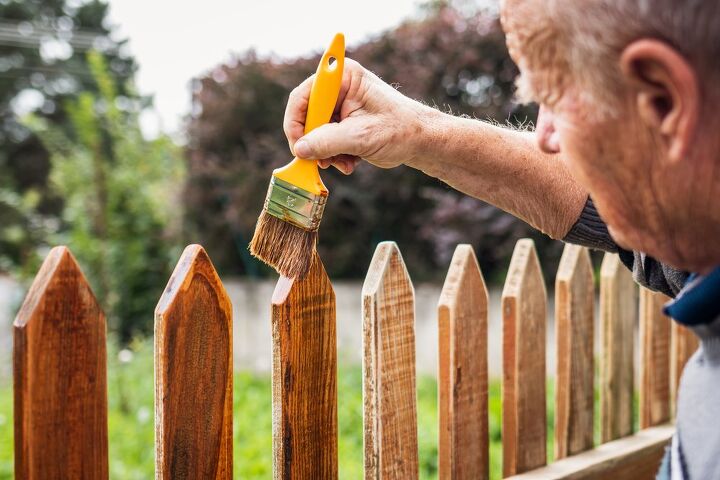How Much Stain Do I Need For A Fence? (Find Out Now!)

Ahh…The white picket fence. Or wait. Maybe it’s a honey oak stained fence. Or maybe it’s a richer pine. Or a blue stained fence. Staining your fence is a good way to extend the lifespan of your fence, prevent pests from eating it up, and also adds a splash of color. The problem comes at shopping. I mean, how much stain do you need for a fence?
Most fence stains will write how much coverage they offer on the can in a “square feet per gallon” measurement. To find out how much stain you need, measure the square footage of your fence and then divide that by the coverage they offer.
One of the hardest things to figure out is the amount of stain you have to buy. Thankfully, with the help of a calculator, you won’t have to be too worried about it. It’s a cinch.
Do You Need Exterior Home Paint or Stain Services?
Get free, zero-commitment quotes from pro contractors near you.

Before We Begin: Measure Your Fence!
The first thing you need to do is make sure to measure your fence. You need to get the square footage. To do this, measure the length and the width. Then multiply those two values together. That’s the square footage of one side of your fence. If you want to paint both sides of your fence, you will need to multiply that value by two.
This final value (length x width x 2) is what we are going to call then total square footage of your fence.
How To Find Out How Much Wood Stain You Need
Wood stain manufacturers realize that each type of stain is going to have a different viscosity. Thicker stains will need to have more gallons per 1000 square feet than thinner ones. Because stains can vary greatly in their coverage, manufacturers actually mention how much a gallon of their stain will cover on the can.
Here’s the quick scoop on how you can calculate your wood stain quantity:
- First, calculate the total square footage of your fence. Write this down on a piece of paper or snapshot it on your cellphone.
- Go to the hardware store and pick out a wood stain that you like. Actually, you might want to pick more than one stain. This way you can take a look at each one and find the one that gives you the most bang for your proverbial buck.
- Look at the coverage rate on the side of the can. Take note of this coverage. If you are on a budget, pick the stain that offers more coverage per gallon.
- Whip out a calculator and divide the total square footage of your fence by the coverage per gallon. So, if your fence’s square footage is 1000 and the coverage is 200 square feet, you should get a total required amount of five gallons.
- If you have a decimal answer, round up to the nearest gallon. Even if it’s just a quarter of a gallon off, you need to buy that extra bucket. Otherwise, you’re going to end up with a partially finished fence! Diluting stain is not a bright idea, ya know.
What If You Can’t Find A Coverage Rate On Your Stain’s Can?
Though the most common practice is to put the coverage amount on the side or back of the stain’s can, not all companies do this. Personally, I think that’s a bad marketing move and that you should avoid picking one of these stains if at all possible.
Of course, I also understand the act of falling in love with that one perfect shade of brown for your fence. So, if you can’t avoid it, it’s good to know that the average gallon of wood stain will cover between 150 to 300 square feet of wood. This depends on the age and porosity of the wood. Less porous wood needs less stain.
In most cases, people can get away with assuming that they will get 200 square feet of coverage per gallon of wood stain. To estimate your coverage, just follow the steps above with an assumed coverage rate of 200.
How Many Coats Of Stain Should I Expect To Add?
This all depends on the type of stain that you want to get, as well as the type of wood. Here’s what you need to know about the coats of stain:
- Most full-color stains will require only one coat of stain for a complete look. This is why most people like full coverage stains.
- Semi-transparent stains may require two coats. Apply the second coat one hour after the first. If you need a third coat for whatever reason, you may need to wait an additional hour so that the coats will sink in and set.
- Sheer and transparent stains can vary on coats. If you just need a light tint, one coat is enough. If you want full coverage, it may take two to three coats to complete.
- Most stains will have the number of coats required written on the side of their box or bucket. Before you feel totally lost, read the side of the bucket. It might have the answers to your questions.
How Much Money Should You Set Aside For Wood Stain?
It all depends on how long your fence is and the type of stain that you want to get. You should expect to pay around $20 to $40 per gallon for most wood stains. A typical 5-gallon bucket of wood stain will be between $110 to $170, depending on the stain type and the brand.
This is all you should know if you want to DIY your own wood stain project, especially when it comes to fencing. However, things get a little bit more expensive if you want to make sure that you get the job done professionally. Most homeowners will pay between $750 and $4,250 to stain their fences professionally.
How much you should expect to pay for a professional stain job depends on the size of the fence, the type of the stain, as well as the area that you live in. Most small, low fences will be pretty cheap to professionally cover. So, if you want to get it done, that’s a good way to do it.
Do You Need Exterior Home Paint or Stain Services?
Get free, zero-commitment quotes from pro contractors near you.

Related Questions
How often should you stain a wooden fence?
Fences seem to get a lot of abuse from the outdoors, and not just from sunlight and rain. Animals and plants can wear them down too. To ensure that your fence stays in tip-top shape, you should expect to add a coat of stain every two to three years. This will protect the wood in your fence and also prevent your fence from becoming discolored as a result of exposure to the elements.
What is the best time of year to stain a wooden fence?
Wood stains are remarkably temperature-sensitive, which is why you have to pick your season carefully. Most stains do best between 50 to 80 degrees Fahrenheit. This usually means that mid-spring to early summer will present the best conditions for your fence staining session. Ideally, you’ll choose the season which is less rainy, since water can wreck stains.Above all, you need to avoid trying to restain your wooden fence during the winter. The low temperatures of winter can make your stain difficult to manage. At best, you’ll have an uneven stain. At worst, the low temperatures can actually cause the stain to spoil.
Should you try to spray or roll on stain for a wooden fence?
Both methods can actually work well on fences as long as you are skilled in application. If your fence is very close to your home, it may be better to get a roll-on application going simply because spray can blow onto your home’s siding. However, most people prefer to get a sprayer for wooden fence stains.It gives you a clean, seamless, and even coat with minimal chances of missing a spot, go for the air brush.

Ossiana Tepfenhart is an expert writer, focusing on interior design and general home tips. Writing is her life, and it's what she does best. Her interests include art and real estate investments.
More by Ossiana Tepfenhart



























